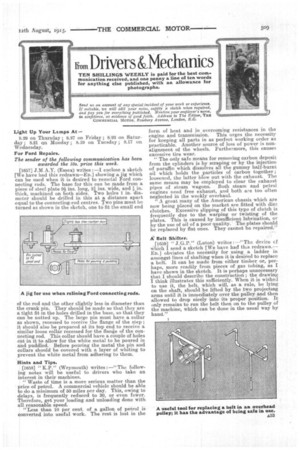No. Drivers &Mechanics
Page 21

If you've noticed an error in this article please click here to report it so we can fix it.
TEN SHILLINGS WEEKLY is paid for the best communication received, and one penny a line of ten words for anything else published, with an allowance for photographs.
Send us an account of any sPecial incident of your work or exPerience. If suitable, we will edit your notes, supply a sketch when required, and ibay you for everything published. Mention your employer's name, in confidence, as evidence of good faith. Address to The Editor, THE COMMERCIAL MOTOR, Rosebery Avenue, London, E.C.
Light Up Your Lamps At —
8.29 on Thursday; 8.27 on Friday ; 8.26 on Saturday; 8.21 on Monday ; 8.19 on Tuesday ; 8.17 on Wednesday.
For Ford Repairs.
The sender of the following communication has been awarded the 108. prize this week.
[1657] J.M.A.Y. (Essex) writes :—I enclose a sketch [We have had this redrawn—En.] showing a jig which can be used when it is desired to Temctal Ford connecting rods. The base for this cart be made from a piece of steel plate 911ins. long, 21 ins. wide, and in. thick, machined on both sides. Two holes 1 in. diameter should be drilled in this at a, distance apart equal to the connecting-rod centres. Two pins must be turned as shown in the sketch, one to fit the small end
of the rod and the other slightly less in diameter than the crank pin. They should be made so that they are a tight fit in the holes drilled in the base, so that they can be nutted up. The large pin must have a collar as shown, recessed to receive the flange of the step ; it should also be prepared at its top end to receive a similar loose collar recessed for the flange of the connecting rod. This collar should have a couple of holes cut in it to allow for the white metal to be poured in • and puddled. Before pouring the metal the pin and collars should be covered with a layer of whiting to prevent the white metal from adhering to them.
Hints and Tips.
[1658] " K.P." (Weymouth) writes :—" The following notes will be useful to drivers who take an interest in their machines.
"Waste of time is a more serious matter than the price of petrol. A commercial vehicle should be able to do a minimum of 50 miles per day. This, owing to delays, is frequently reduced to 30, or even fewer. Therefore, get your loading and unloading done with all reasonable speed.
"'Less than 10 per cent, of a gallon of petrol is converted into useful work. The rest is lost in the form of heat and in overcoming resistances in the engine and transmission. This urges the necessity for keeping all parts in as perfect working order as practicable. Another source of loss of power is nonalignment of the wheels. Furthermore, this causes excessive tire wear.
"The only safe means for removing carbon deposit from the cylinders is by scraping or by the injection of paraffin which dissolves all the gummy half-burnt oil which holds the particles of carbon together ; loosened, the latter blow out with the exhaust. The same means may be employed to clear the exhaust pipes of steam wagons. Both steam and petrol engines need free exhaust, and both are too often neglected in the weekly overhaul. A great many of the American chassis which are now being placed on the market are fitted with disc clutches. Excessive slipping of this type of clutch is frequently due to the warping or twisting of the plates. This is caused by insufficient lubrication, or by the use of oil of a poor quality. The plates should be replaced by flat ones. They cannot be repaired."
Belt Shifter.
[1659] " J.G.P." (Luton) writes :—" The device cf Which I send a sketch [We have had this redrawn.— ED.] obviates the necessity for using a ladder in amongst lines of shafting when it is desired to replace a belt. It can be made from either timber or, perhaps, more readily from pieces of gas tubing, as I have shown in the sketch. It is perhaps unnecessary that I should describe the construction ; the drawing I think illustrates this sufficiently. When it is wished to use it, the belt, which will, as a rule, be lying on the shaft, should be lifted by the two projecting arms until it is immediately over the pulley and then allowed to drop nicely into its proper position. It only remains to run the belt then on to the pulley of the machine, which can be done in the usual way by hand."






















